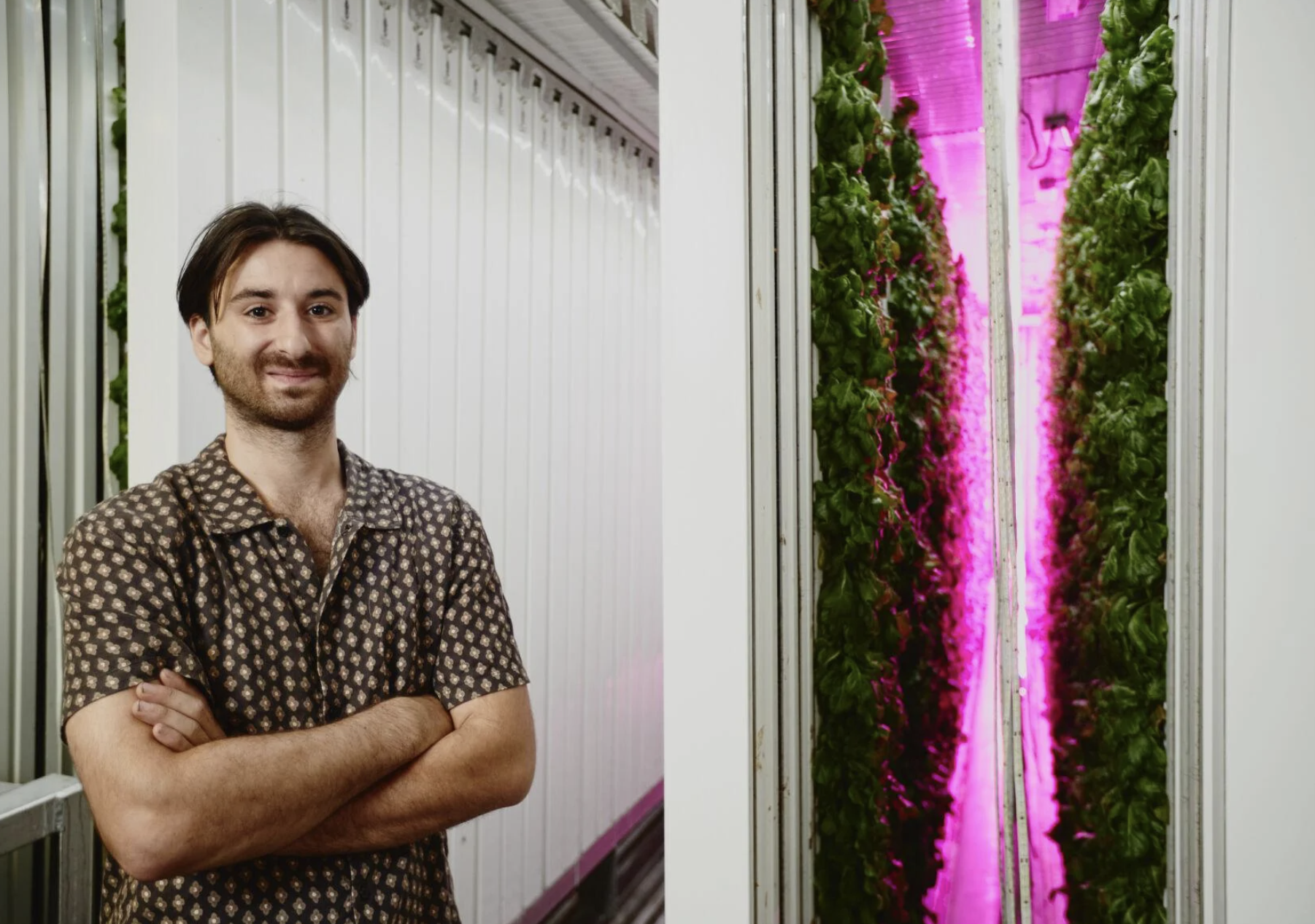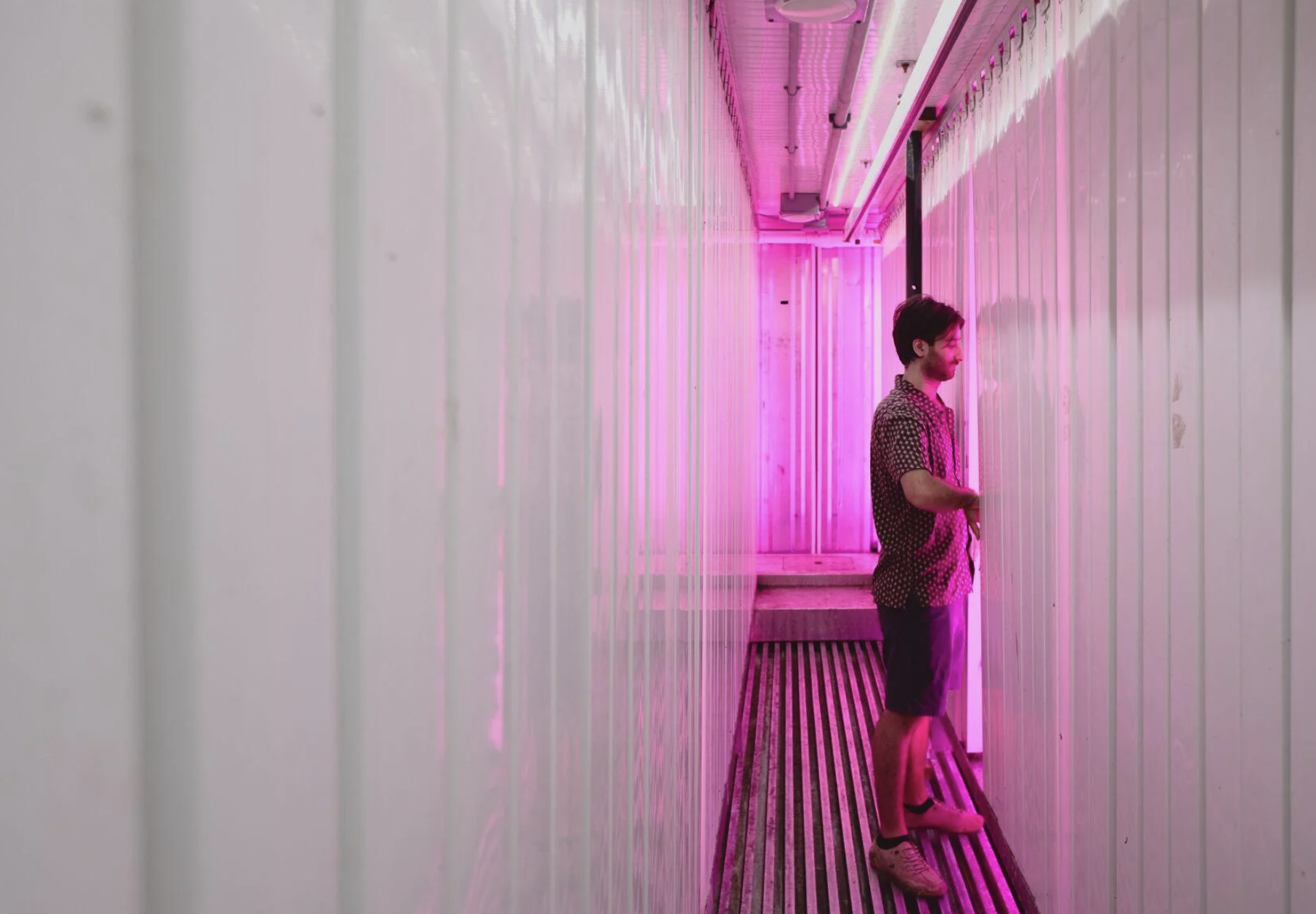WNY Container Farming, LED Lighting Companies Team Up With UB On AI Solutions For Plant Health
July 20, 2023
Muk Musleh of StarCo Lighting demonstrates its six-channel grow lights at a 2022 lighting conference. (provided photo)
Gabe Bialkowski of Ellicottville Greens in one of its growing facilities. Ellicottville Greens, in partnership with University at Buffalo and StarCo Lighting, are working on a project to develop lighting systems for vertical growing operations, Thursday, July 20, 2023.
Anew Buffalo venture thinks it can help plants grow better indoors by using artificial intelligence to fine-tune the light they are exposed to and monitor their health.
If they are right, the computer-enhanced lighting and imaging system they envision will make it easier to grow plants indoors and extend the growing season in places like Buffalo, where summers are short and winters long.
The idea is the brainchild of a University at Buffalo graduate who just bought an industrial LED lighting company and is teaming up with the CEO of a local indoor farming business that grows vegetables and herbs in repurposed shipping containers.
Muk Musleh got dual bachelor's degrees in electrical and computer engineering from UB in 2009 and last year bought StarCo Lighting, the LED lighting company he helped lead since 2016.
Gabe Bialkowski founded Ellicottville Greens, the container farming company that’s supplying lettuce, herbs and microgreens to 14 school districts and a hospital in Cattaraugus County and is expanding to the City of Buffalo.
Gabe Bialkowski of Ellicottville Greens in one of its growing facilities. Ellicottville Greens, in partnership with University at Buffalo and StarCo Lighting, are working on a project to develop lighting systems for vertical growing operations, Thursday, July 20, 2023. Joshua Thermidor/Buffalo News
The companies just got a research grant to partner with artificial intelligence experts at UB to devise a product combining tunable lighting with advanced imaging and AI to better care for plants in indoor growing operations like Ellicottville Greens.
Here's how it works:
Indoor growers know plants grow better under light of differing colors and intensity. And those combinations can vary for each stage of growth. Lighting manufacturers are competing to produce lighting that can be fine-tuned for different crops to make them grow best.
Using lighting "recipes" tailored for each type of plant can produce better yields – more lettuce, more herbs, more mushrooms, to name the most common indoor crops. Higher yields lower the cost of indoor growing by making it more efficient.
But adding artificial intelligence to the mix could make the results even better.
StarCo's newest tunable grow lights allow growers to adjust their color and temperature over six to 10 segments of the spectrum to find the best lighting for each crop.
Musleh wants to up StarCo's game by equipping its lights with advanced cameras to capture images of the growing plants under different colors of light and use AI to monitor plant health up close and around the clock and "learn" to identify and flag potential problems.
FuzeHub, a nonprofit organization that supports manufacturers in New York by funding research and advancements, approved $50,000 for the project to equip “smart” grow lights to detect threats like bacteria or pests in individual plants before they become a threat to entire crops.
The money will help supply vertical growing racks, LED lighting panels and multispectral cameras and sensors in the lab of UB professor Jinjun Xiong for a yearlong project to develop the AI product and a database of plant images in different stages of growth under varying colors of light, Xiong said.
While the grant isn’t huge, the payoff could be groundbreaking for the blossoming indoor farm industry and the problem of food insecurity in local communities, like Buffalo’s East Side and food-challenged nations around the world, Xiong said.
“I’m most interested in research that is part of developing solutions that are meaningful to solve societal challenges,” Xiong said. “And this one is trying to solve the problem of food shortage.”
Professor Jinjun Xiong speaks at UB's AI Institute for Exceptional Education retreat in April 2023. Douglas Levere University at Buffalo
Ellicottville Greens and StarCo have both developed innovative methods and designs to deliver more efficient and less expensive solutions for their industries.
Bialkowski, a graduate of Canisius University with a master’s in computer software engineering from Rochester Institute of Technology, launched a music company in Los Angeles in 2013 and ran it for five years when the indoor farming industry started picking up on the West Coast.
He realized indoor farming could extend his native Buffalo’s growing season from a few months to year-round and decided to move home to pursue it.
In 2019, the company started buying used shipping containers and converting them to indoor farms, using organic compounds, recycled water and solar energy to grow lettuce and microgreens in vertical towers that can produce 1,000 heads of lettuce per container per week, Bialkowski said.
Now a team of 12 people tends 37 of the 40-foot containers at locations in Clarence and Olean which provide fresh produce within a 50-mile radius, vastly reducing the transportation costs and carbon footprint that plague the produce ecosystem.
Next month, they will move 20 containers to a site on Lombard Street in Buffalo to supply local restaurants and food distributors. They are in the process of bringing clusters of container farms to Louisville and Indianapolis, Bialkowski said.
“The average portion of produce on your plate travels 1,500 miles to get there,” Bialkowski said. “Over 70% of the produce consumed in New York is from out of state. In a climate like Buffalo’s, where you can only grow outside two months a year, we thought indoor growing would be a good solution for affordable, sustainable food.”
Like other indoor farming operations, Ellicottville Greens uses LED lighting in several spectrums to grow its plants, but relies heavily on lighting “recipes” supplied by manufacturers. They also rely on individual workers to monitor the plants Monday through Friday to ensure they are pest- and disease-free.
Those functions could get a big assist from combining AI monitoring with LED lighting systems, an innovative use of AI that other grow light companies are also exploring – but not with products as "tunable" as StarCo’s, Musleh said.
Musleh previously worked as the LED lighting expert for Ford Motor Co. as it changed the lighting in its facilities to LED starting in 2013. In 2016 he joined StarCo as chief operating officer at its Buffalo headquarters.
He had horticultural lighting in mind as a target market when he and business partner John Calabro bought StarCo from its Chinese shareholders last year. The company was already a leader in supplying cost-efficient LED lighting for industrial environments like General Motors’ plants. Musleh wanted to branch into lighting that serves indoor farming for New York’s new cannabis industry and the sustainable agriculture movement.
The company designed an interactive six-channel tunable light that growers can experiment with to “dial in” their preferred light spectrum for the type of plant and stage of growth of a given crop, Musleh said. The product won a 2022 BrightStar Award from LEDs magazine for innovation in horticultural lighting.
StarCo also makes an “economy” three-channel light that’s more affordable than comparable products, Musleh said. Growers can buy one or two of the high-end lights for R&D – “research and deployment” – and use the “recipes” they devise for the economy grow lights, which can number in the thousands at some indoor farms.
The new research aims to devise lights that can monitor plant health in ways that might not be detectable by the human eye, Musleh said.
Xiong’s team will equip tunable LED grow lights with multispectral cameras to store images of greens at every stage and lighting combination and store them in a database that can be viewed using AI, which could then identify threats to the plants – from a need for more moisture to pests and diseases – and proactively flag them so the grower can nip them in the bud.
“If we can use the cameras as a data source and input human knowledge as to what type of plant disease is important to detect … maybe we can monitor plants more automatically and not have to rely on human observers all the time, which gets expensive,” Xiong said.
At the end of a year, Musleh said “at the very least” they will have a product that can alert growers to changes in plant health, if not automatically provide treatment such as shining UV light to stifle mildew growth.
Gabe Bialkowski of Ellicottville Greens inspects plants in one of its growing facilities. Ellicottville Greens, in partnership with University at Buffalo and StarCo Lighting, is working on a project to develop lighting systems for vertical growing operations, Thursday, July 20, 2023. Joshua Thermidor/Buffalo News
Bialkowski said indoor farming has already proven itself as an agriculture sector for producing fresh, local produce using less space, energy, labor and transportation while offering more consistency regardless of season and weather.
The next step is refining it to make it even more efficient and affordable, he said.
"We think this will allow us to create more efficient indoor farms,” he said.








